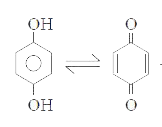Given , . Calculate electrode potential at pH = 5.
The correct Answer is:-0.93
To calculate the electrode potential at pH = 5 for the reaction:
2H2O→O2+4H++4e−
with a standard electrode potential E0=−1.23V, we will use the Nernst equation:
Step 1: Write the Nernst Equation
The Nernst equation is given by:
E=E0−0.0591nlogQ
where:
- E is the electrode potential,
- E0 is the standard electrode potential,
- n is the number of electrons transferred in the reaction,
- Q is the reaction quotient.
Step 2: Identify n
From the balanced equation, we see that 4 electrons are transferred. Therefore, n=4.
Step 3: Calculate the Reaction Quotient Q
The reaction quotient Q for the given reaction can be expressed in terms of the concentration of H+:
Q=(H+)4
Step 4: Substitute (H+) at pH = 5
At pH = 5, the concentration of H+ ions can be calculated using the formula:
(H+)=10−pH=10−5M
Thus,
Q=(10−5)4=10−20
Step 5: Substitute Values into the Nernst Equation
Now we can substitute the values into the Nernst equation:
E=−1.23−0.05914log(10−20)
Step 6: Calculate log(10−20)
Using the properties of logarithms:
log(10−20)=−20
Step 7: Substitute log(10−20) into the Nernst Equation
Now substituting this back into the equation:
E=−1.23−0.05914×(−20)
Step 8: Simplify the Equation
Calculating 0.05914:
0.05914=0.014775
Now substituting this value:
E=−1.23+0.014775×20
Calculating 0.014775×20:
0.014775×20=0.2955
Step 9: Final Calculation
Now substituting this back into the equation:
E=−1.23+0.2955=−0.9345V
Rounding to two decimal places, we get:
E≈−0.93V
Final Answer
The electrode potential at pH = 5 is approximately:
E≈−0.93V
---
The Nernst equation is given by:
- E is the electrode potential,
- E0 is the standard electrode potential,
- n is the number of electrons transferred in the reaction,
- Q is the reaction quotient.
From the balanced equation, we see that 4 electrons are transferred. Therefore, n=4.
The reaction quotient Q for the given reaction can be expressed in terms of the concentration of H+:
At pH = 5, the concentration of H+ ions can be calculated using the formula:
Now we can substitute the values into the Nernst equation:
Using the properties of logarithms:
Now substituting this back into the equation:
Calculating 0.05914:
Now substituting this back into the equation:
The electrode potential at pH = 5 is approximately:
Similar Questions
One ecologically important equilibrium is that between carbonate and hydrogen carbonate ions in natural water. This standard Gibb's energies of formation of CO−23(aq) and HCOΘ3(aq) are −527.8kJmol−1 and −586.8kJmol−1 respectively.
For water,
2H2O(l)+2eΘ→H2(g)+2OHΘ(aq),EΘRP=−0.83V
2H2O→O2+4H++4eΘ,EΘOX=−1.23V
Calculate the potential of a cell of pH=7 in which the cell reaction is-
Na2CO3(aq)+H2O(l)→NaHCO3(aq).+NaOH(aq)View SolutionOne ecologically important equilibrium is that between carbonate and hydrogen carbonate ions in natural water. This standard Gibb's energies of formation of CO−23(aq) and HCOΘ3(aq) are −527.8kJmol−1 and −586.8kJmol−1 respectively.
For water,
2H2O(l)+2eΘ→H2(g)+2OHΘ(aq),EΘRP=−0.83V
2H2O→O2+4H++4eΘ,EΘOX=−1.23V
What is the standard potential Couple of HCO−3/CO−23,H2.View SolutionGiven that, Co3++e−→Co2+,E∘=+1.82V
2H2O→O2+4H++4e−,E∘=−1.23V.
Explain why Co3+ is not stable in aqueous solutions.View SolutionOne ecologically important equilibrium is that between carbonate and hydrogen carbonate ions in natural water. This standard Gibb's energies of formation of CO−23(aq) and HCOΘ3(aq) are −527.8kJmol−1 and −586.8kJmol−1 respectively.
For water,
2H2O(l)+2eΘ→H2(g)+2OHΘ(aq),EΘRP=−0.83V
2H2O→O2+4H++4eΘ,EΘOX=−1.23V
The value of pKa for HCOΘ3 (aq) is (approx):View SolutionThe standard reduction potential for the half cell :
NOc−3(aq)+2Hc−+e−→NO2(g)+H2O is 0.78V.
Calculate the reduction potential in 8MH⊕.View Solution50mL of 0.1MCuSO4 solution is electrolysed with a current of 0.965A for a period of 200sec. The reactions at electrodes are:
Cathode: Cu2++2e−→Cu(s)
Anode: 2H2O→O2+4H++4e.
Assuming no change in volume during electrolysis, calculate the molar concentration of Cu2+,H+ and SO2−4 at the end of electrolysis.View SolutionFor the half cell,

+2H+2e−.E0=
1.30 V. At pH=2, electrode potential of the given quinhydrone half cell is :View SolutionE0=−08275V for the reaction, 2H2O+2e−→2OH−+H2.Calculate the ionic product for the reaction, 2H2O<⇒H3O++OH−.
View SolutionPotential for some half cell reactions are given below. On the basis of these mark the correct answer.
(i) H+(aq)+e−→(12)H2(g) E∘cell=0.00V
(ii) 2H2O(l)→O2(g)+4H+(aq)+4e−, Ecell=1.23V
(iii) 2SO2−4(aq)→S2O2−8(aq)+2e−,E∘cell=1.96VView SolutionIn acid medium, MnOc−4 is an oxidizing agent.
MnOc−4+8H⊕+5e−→Mn2++4H2O
If H⊕ ion concentration is doubled, electrode potential of the half cell MnOc−4,Mn2+∣Pt willView Solution

